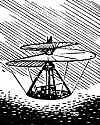|
|
|
12. Patience and Practice
A Radio Talk by Charles F. Kettering
In these talks, we have often
stressed the value of patience in developing new things because, as a
rule, it takes a long time for an idea to grow up. Today, we have an
outstanding example of this from the career of a young Russian who
over 40 years ago started experiments in aviation which are just now
coming into use.
 Fifty-five years ago, Igor Sikorsky
was born in Kiev,
in Southern Russia. Igor grew up in a scientific atmosphere -
his father was a professor of psychology and his mother was
educated in medicine. His mother greatly admired Leonardo da Vinci
and often told her son of the many accomplishments of the great artist,
but da Vinci's flying machine designs made an indelible impression
on the boy's mind, even though they were made 400 years before.
Fifty-five years ago, Igor Sikorsky
was born in Kiev,
in Southern Russia. Igor grew up in a scientific atmosphere -
his father was a professor of psychology and his mother was
educated in medicine. His mother greatly admired Leonardo da Vinci
and often told her son of the many accomplishments of the great artist,
but da Vinci's flying machine designs made an indelible impression
on the boy's mind, even though they were made 400 years before.
With this background, it was only natural that
in 1908, when he read
about the Wright
brothers, he resolved to make flying his career,
so he began to collect all the information he could find on the
subject. He remembered da Vinci's helicopter sketch, and this may have
influenced him to work on a machine that would rise vertically.
|
|


 Fifty-five years ago,
Fifty-five years ago, 





